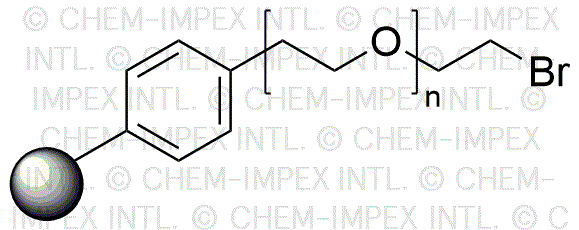TentaGel MB Br (0.4 - 0.6 mmol/g, 140 - 170 µm) is widely utilized in research focused on:
- Solid-Phase Synthesis: This compound serves as a versatile support for solid-phase peptide synthesis, allowing researchers to efficiently create peptides with high purity and yield.
- Drug Discovery: In the pharmaceutical industry, it is used to create combinatorial libraries of compounds, facilitating the identification of potential drug candidates through high-throughput screening.
- Bioconjugation: The chemical is employed in bioconjugation techniques to attach biomolecules to surfaces or other molecules, enhancing the development of targeted therapies and diagnostics.
- Material Science: It is utilized in the development of functionalized materials, such as sensors and catalysts, where its unique properties can improve performance and specificity.
- Analytical Chemistry: Researchers leverage this compound in chromatographic techniques for the separation and analysis of complex mixtures, benefiting from its stability and reactivity.
General Information
Properties
Safety and Regulations
Applications
TentaGel MB Br (0.4 - 0.6 mmol/g, 140 - 170 µm) is widely utilized in research focused on:
- Solid-Phase Synthesis: This compound serves as a versatile support for solid-phase peptide synthesis, allowing researchers to efficiently create peptides with high purity and yield.
- Drug Discovery: In the pharmaceutical industry, it is used to create combinatorial libraries of compounds, facilitating the identification of potential drug candidates through high-throughput screening.
- Bioconjugation: The chemical is employed in bioconjugation techniques to attach biomolecules to surfaces or other molecules, enhancing the development of targeted therapies and diagnostics.
- Material Science: It is utilized in the development of functionalized materials, such as sensors and catalysts, where its unique properties can improve performance and specificity.
- Analytical Chemistry: Researchers leverage this compound in chromatographic techniques for the separation and analysis of complex mixtures, benefiting from its stability and reactivity.
Documents
Safety Data Sheets (SDS)
The SDS provides comprehensive safety information on handling, storage, and disposal of the product.
Product Specification (PS)
The PS provides a comprehensive breakdown of the product’s properties, including chemical composition, physical state, purity, and storage requirements. It also details acceptable quality ranges and the product's intended applications.
Certificates of Analysis (COA)
Search for Certificates of Analysis (COA) by entering the products Lot Number. Lot and Batch Numbers can be found on a product’s label following the words ‘Lot’ or ‘Batch’.
*Catalog Number
*Lot Number
Certificates Of Origin (COO)
This COO confirms the country where the product was manufactured, and also details the materials and components used in it and whether it is derived from natural, synthetic, or other specific sources. This certificate may be required for customs, trade, and regulatory compliance.
*Catalog Number
*Lot Number
Safety Data Sheets (SDS)
The SDS provides comprehensive safety information on handling, storage, and disposal of the product.
DownloadProduct Specification (PS)
The PS provides a comprehensive breakdown of the product’s properties, including chemical composition, physical state, purity, and storage requirements. It also details acceptable quality ranges and the product's intended applications.
DownloadCertificates of Analysis (COA)
Search for Certificates of Analysis (COA) by entering the products Lot Number. Lot and Batch Numbers can be found on a product’s label following the words ‘Lot’ or ‘Batch’.
*Catalog Number
*Lot Number
Certificates Of Origin (COO)
This COO confirms the country where the product was manufactured, and also details the materials and components used in it and whether it is derived from natural, synthetic, or other specific sources. This certificate may be required for customs, trade, and regulatory compliance.

